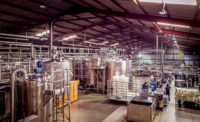HACCP: A View to the Bottom Line

During the past 10 to 15 years, the system known as Hazard Analysis & Critical Control Points (HACCP) has emerged as the leading program for ensuring food safety. During this time, HACCP, as a food safety strategy, has steadily gained favor with regulatory officials, foodservice operators and food processors around the world. Most experts agree that the strength of HACCP derives from the fact that it is a science-based and objective approach. The experts also will agree that a proactive view to food safety is preferable to the conventional “hold, inspect, test and release” methods still being used today. There is no debating the fact that a properly constructed HACCP plan, when cast with appropriately robust prerequisites, can be an effective safeguard against a food safety failure.
While the HACCP approach to food safety assurance has been around for nearly 40 years, the question remains: Why has it taken so long for the food industry to recognize the bottom-line benefits of HACCP? There are a few answers to this query. First, while the government has moved to advance HACCP, the food industry most often has been a reluctant “partner.” Several factors appear to have contributed to industry’s cautious approach to embracing HACCP. The most prominent concerns revolve around the government’s increased regulatory authority over food processing operations.
The industry also has frequently cited concern for loss in productivity due to restrictions that might be associated with unnecessarily onerous and overly prescriptive regulations. The U.S. Food and Drug Administration (FDA) recently enacted juice HACCP regulations, which is in many ways emblematic of this concern. The prescriptive regulations essentially have removed control over significant elements of juice manufacturing operations from the hands of the processors. Consequently, the juice HACCP regulations are viewed by some as unwarranted restrictive and an impediment to productivity. This is a myopic view that fails to consider the positive economic impact of using a HACCP-based manufacturing strategy. When properly developed and implemented, HACCP should both enhance food safety and provide an economic benefit to those companies that embrace this system.
For some within the food industry, the fact that the government has been so aggressive in embracing HACCP may have tainted industry’s support of HACCP as a strategy. (This is a classical case of “I’m from the government and I’m here to help.”) Further, in a number of sectors, HACCP is increasingly viewed as strictly an inspection and enforcement tool—rather than a business process to assist companies in achieving their key financial objectives. For companies in the business of producing food and ensuring that safe food reaches the consumer, this view is counterproductive.
From the regulatory perspective, HACCP is viewed as exquisitely compatible with inspection and enforcement activities. Under HACCP, inspection and enforcement are focused on evaluating conditions or practices at a limited number of points across the expanse of a manufacturing process. That is, inspection and enforcement apply only to those points of the process critical to achieving food safety. This focused approach is both efficient and cost-effective.
Regulated Savings?
Beginning in 1974, the regulatory community recognized the tremendous benefit of HACCP when the U.S. Food and Drug Administration’s (FDA) Bureau of Foods implemented critical control point (HACCP) inspection of “Frozen Heat-and-Serve Type Foods.” Twelve years later the agency provided an official definition for “critical control point” in the U.S. Code of Federal Regulations at 21 CFR 110. This seemingly innocuous event was a foreshadowing of the agency’s interest in HACCP, as well as its intent to use this system as a means to achieve its regulatory objectives with respect to food safety.
In recent years, both FDA and the U.S. Department of Agriculture’s (USDA) Food Safety Inspection Service (FSIS) have promulgated mandatory HACCP regulations. FSIS led the way with the 1996 publication of its final rule for the Pathogen Reduction and Hazard Analysis and Critical Control Point System for the meat and poultry industries. FDA has subsequently published HACCP-based regulations for both the seafood and juice industries. Moreover, it appears that both agencies are actively seeking opportunities to further extend HACCP regulations to cover an even broader portion of the food industry. A review of recent FDA and USDA documents bears out this hypothesis.
The October 2001 FDA Backgrounder reports that the agency is considering the development of regulations that would establish HACCP as the principal safety standard throughout the food industry, including both domestic and imported food products. The agency document also reports that FDA has initiated voluntary pilot HACCP programs with food companies to determine the degree to which such regulations would be feasible. Initially, these pilot programs have involved an array of foods, including dairy, cheese, frozen dough, breakfast cereals, salad dressing, bread, flour and other products. According to the January 2002 FSIS Backgrounder, the USDA is actively seeking to expand the role of its HACCP-Based Inspection Models Project (HIMP) within the meat and poultry processing industry. If these changes are approved and implemented, how would they affect the food industry?
Consider this: FSIS estimates that the annual public health benefits from the implementation of HACCP, in terms of reduced foodborne illness costs—including medical care and lost work time— range from $990 million to $3.7 billion. These benefits, while significant, are not always appreciated. For example, the FSIS inspectors’ union was initially apprehensive about supporting HACCP. The union expressed concern that the agency’s push for HACCP-based inspection would result in loss of employment for its membership. Industry, too, viewed FSIS’s initial overtures toward HACCP based inspection with more than a modicum of trepidation. Their primary source of concern was for the cost and content of the agency’s programs. More recently FSIS’s Pathogen Reduction and HACCP program has been challenged in the courts. The Federal District Court, in the Supreme Beef Processors, Inc. vs. USDA, ruled that certain aspects of the HACCP program exceed the agency’s mandate.
The fact that many food industry executives are profoundly lacking in a fundamental understanding of HACCP seems largely responsible for industry’s reluctance to embrace this system. In many corporations, the chief executive officer’s (CEO) understanding of HACCP is derived from technical specialists within the organization. These specialists are from central research, product development, quality assurance, microbiology, or even the legal department. Typically, these specialists are lacking significant business or manufacturing experience. Accordingly, the CEO’s view of HACCP is frequently stilted or skewed toward the technical, scientific or regulatory aspects of the discipline. ‘While it is laudable that the CEO should have a technical understanding of the HACCP processes, it is equally important for the people managing the business to have an appreciation for the financial implications of using a HACCP-based manufacturing strategy. The failure to establish HACCP’s bottom-line relatedness is frequently at the crux of the matter when it comes to a company’s willingness to embrace this system.
HACCP is a tool that is intended to aid processors in the realization of key business objectives. These objectives are increased productivity, profitability and growth. The financial aspects of the HACCP approach appear to elude many processors, food safety experts, consultants, academics and HACCP practitioners. A properly constructed, implemented and executed HACCP system should result in improved yields, earnings and profitability for most food companies. These results are primarily achieved by reducing the number of defects that are produced by the manufacturing operations. In the case of HACCP, the defects are of a special class comprised of chemical, physical and biological hazards that manifest from losing control of the manufacturing processes. In other words, HACCP can be used as a process control strategy in food manufacturing operations to prevent the production of defects that have an associated risk to the public health. Thereby, improving yields, line efficiencies, overall plant capacity, earnings, and of course, food safety.
Developing a HACCP plan demands broad knowledge of the food, its intended use and hazardous constituents. HACCP development also requires an exquisite understanding of the processes use in the production, packaging, storage and distribution of the food. Moreover, HACCP development demands knowledge of the manufacturing process’ capability with respect to preventing the production of foods that contain dangerous biological, chemical or physical defects.
Process control is the force that drives the success of HACCP. Of the seven principles of HACCP, it is clear that a majority are focused on understanding and controlling the manufacturing process. Critical control points (CCPs), for example, only can be established after the capability of the manufacturing process has been determined. Process capability in the context of HACCP most frequently is an expression or function of the sensitivity of the preventive measure designated to eliminate or control the defect. For example, consider that a pulsed electric field (PEF) process with 5D lethality against Listeria monocytogenes in fluid milk would be unsafe for use in milk processing if this pathogen was present in numbers greater than the capability (lethality) of the process. In other words, establishing a CCP around a preventive measure that is not capable of mitigating the identified hazard is to ensure the production of unsafe food.
Process capability in the context of HACCP is expressed as a critical limit. The critical limits are monitored for confirmation of process control. Moreover, it is the data gathered from monitoring these limits that provides the first opportunity to implement corrective actions to maintain control of the process. Likewise, it is the monitoring of the critical limits that provides for the eloquent documentation of the process, which is the very aspect of HACCP that has long been the attraction of the regulatory community.
Process capability analysis is the hard work of HACCP. It requires data and the skills of specialists to analyze these data so that they are meaningful and useful in developing an effective, science-based process control strategy. An experienced food safety consultant, knowledgeable in both HACCP and food processing operations, can add great value to a company’s efforts in this area. Process capability analysis demands a rigorous evaluation of the assumptions of risk used in conducting the hazards analysis for the product or process. In fact, process capability analysis should be a critique of the critical limits defined for the process’ critical control points. Establishing critical limits that are beyond the capability of the process will ultimately jeopardize the integrity of the entire HACCP plan. It appears that this was an issue in the Supreme Beef court case. Succinctly, the processing methods currently used by the meat industry do not appear capable of achieving the critical limits (performance standards) as have been established by FSIS. The predictable consequences of faulty process capability analyses are manufacturing failures and the production of defective, unsafe food.
Regrettably, most companies do not spend the requisite time or resources on this phase of HACCP development. For that reason, they do not receive the full economic benefit of the HACCP manufacturing strategy. With a properly executed and implemented HACCP plan, a reduction in or the elimination of food safety defects from the manufacturing operations is a reasonable expectation.
Producing defective materials is very costly and has a negative impact on the bottom line. Producing food safety defects is an economic detractor for both the food processor and the end user of the company’s products. Food companies routinely report the cost of producing defects (quality and food safety) in the neighborhood of between 3-7°Io of total sales. Most experts agree that these numbers are low and that the true costs are probably in the range of 15-30% of a company’s total sales. Using conventional quality control methods such as inspection, retention, testing and review to prevent defects from entering the trade can increase these costs to 25-30%, or more. Food safety defects are of a special class and the costs of producing this type defect also are significantly more costly. Consider the case of Hudson’s Foods, where the costs of producing and distributing defective, unsafe food quite literally killed the business.
Most CEOs readily appreciate the cost implications associated with producing and distributing defective merchandise. This is especially true when the defective product represents a threat to the public health. The CEO will he quick to recognize labor cost, the cost of goods, the costs of line time and energy costs, as well as the costs associated with inspecting, isolating, rehabilitating, recalling, destroying and litigating claims that arise from consumer exposure to defective goods. The CEO will be quickest to understand the potential harm to the company’s brands, its reputation and profitability that result from incidents involving food safety defects.
Data from the Centers for Disease Control and Prevention (CDC) indicate that the total annual cost of managing foodborne disease outbreaks may be as high as $23 billion. FSIS data, as reported in its final rule on Pathogen Reduction and HACCP, show the total implementation costs for HACCP amounts to between one- and two-tenths of a cent per pound of product. Clearly then, if the government’s estimates are correct, even with industry’s notoriously thin margins, two-tenths of a cent per pound of product is cheap when it comes to ensuring food safety and an even better deal when it returns dollars to the business.
Return on Investment in HACCP
The societal benefits of HACCP are clear. The prevention of pain and suffering or the loss of life due to exposure to unsafe food is without a doubt the most compelling reason for both government and industry to adopt HACCP. Yet, the reality is, HACCP was never intended as an enforcement tool for governmental food inspection agencies. Nonetheless, over the years it has proved to be an efficient and effective means for the regulatory community to achieve its objectives of protecting the integrity of the food supply. According to a recently released CDC surveillance data, there has been a 23% overall drop in bacterial foodborne illnesses in the U.S. since the implementation of HACCP in 1996. Published in the April 19, 2002, issue of CDC’s Morbidity and Mortality Report, the agency stated that the latest surveillance data show that Salmonella, Listeria, Campylobacter and E. coli O157:H7, which are considered the most significant foodborne illness-causing pathogens, made up 21% of the 23% decrease in foodborne infections reported since 2000.
HACCP was originally conceived as a manufacturing strategy for food processors to ensure that the foods they produced were free from the types of defects that could adversely impact the public health. When HACCP is properly developed and applied it is a reasonable expectation that the company using the strategy should receive an economic benefit. This benefit is gained through process control, which results in the reduction or elimination of defects from the manufacturing operations. Improved process control results in increased productivity and profitability. HACCP is not an operating expense; rather it is a source of revenue for the company that embraces it as a business process or manufacturing strategy.
Provided that government data are correct, the nation stands to save millions, if not billions, of dollars as a result of the meat processing industry’s implementation of HACCP. Logically, it follows that the food processing industry would be among the beneficiaries of these cost savings. Preventing the production of defects vis-á-vis process control will reduce the need for expensive product testing and inspection programs, prevent recalls, and reduce expense of litigating consumer complaints. The cumulative effects of these activities are increased productivity, profitability, brand protection and preservation of consumer good will. HACCP is a business and manufacturing process that should reflect favorably on a company’s bottom line.
Larry Keener is the owner and general manager of International Product Safety Consultants (IPSC), Seattle, WA. Founded in 1996, IPSC specializes in food safety microbiology, regulatory affairs and crisis management. The company has clients worldwide, including ConAgra, Nabisco, Kraft, Lipton, Unilever Research (The Netherlands), PurePulse Technologies, and J.M. Smucker. IPSC also is the U.S. representative of Food Science Australia. He is the executive director of the Non-Thermal Processing Alliance. Keener has nearly 30 years of experience in the food processing industry holding positions in private industry, with the state of California and at the National Food Processors Association, and as the director of Product Safety and Regulatory Affairs for Van Den Bergh Foods, Unilever’s largest food products company worldwide. He is a member of the Food Safety Magazine Editorial Advisory Board. He can be reached via e-mail at lkeener@aol.com.
BIBLIOGRAPHY
Bauman, H.E. The HACCP concept and microbiological hazard categories. Food Tech. (28), p. 30. 1974.
Calbert, G.T. Control Strategies for Business and Academia. Personal comm. March 2002.
Deming, WE. The New Economics for Industry, Government and Education. MIT. 1993.
Federal Register. Jan. 19, 2001 (Vol. 66, No.r 13)DHHS/FDA. 21 CFR Part 120 HACCP; Procedures for the Safe and Sanitary
Processing and Importing of Juice; Final Rule.
Harry, M. and R. Schroeder. Six Sigma. Random House. 2000.
Ito, Keith. Microbiological criteria and critical control points in canned foods. Food Tech. (38), p.16. 1974
Katsuyama, AM. Principle of Food Processing Sanitation. Food Processors Institute. 1980.
Keener, L. Mechanistics of selling food safety. Food Testing & Analysis (5)4. Aug./Sept. 1999.
Keener, L. Is HACCP enough for ensuring food safety’? Food Testing & Analysis (5)5. Oct/Nov. 1999.
Keener, L. Chemical and physical hazards: The other food safety risk. Food Testing & Analysis. June/July 2001.
Keener, L. Why HACCP plans are prone to failure. Food Safety Magazine (6)6. Dec/Jan. 2001.
Keener, L. Buying into HACCP, Meat Processing. September 2001.
USDA/FSIS Backgrounders. An Overview of the HACCP-Based Inspection Models Project. January 2002.
U.S. FDA Backgrounder. HACCP: A State-of-the-Art Approach to Food Safety. October 2001.
Looking for a reprint of this article?
From high-res PDFs to custom plaques, order your copy today!








